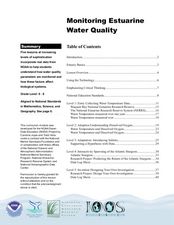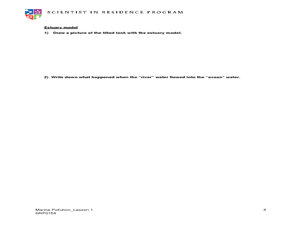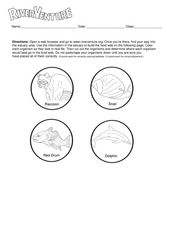University of Waikato
Estuary Metaphors
Mixing metaphors into science. To begin, the instructor leads a discussion about estuaries to determine what the class already knows. Working in small groups, pupils determine how a selected object is similar to an estuary, how it...
American Museum of Natural History
Dive Into Worlds Within the Sea
Make connections between ocean organisms. Individuals explore three different ecosystems in the ocean. With an online interactive, they learn how different organisms depend upon each other. Learners first answer questions to connect...
University of Waikato
Hubbub Estuary
Estuaries attract people—and that can mean trouble. Learners use video and article resources to learn about the struggles of specific estuaries. They follow their discussion with an analysis of an estuary by identifying possible threats.
Biology Junction
Water Biomes
Water covers more than 70 percent of Earth's surface. Scholars learn about both freshwater and saltwater biomes in a simple presentation. They compare and contrast the differences in oxygen levels, food sources, and sunlight to better...
Curated OER
The Gopher Tortoise
Can you believe the gopher tortoise was around when the dinosaurs were walking the Earth. Learn all about this creature that is one of Florida's most popular reptiles. Hands-on-activities and a glossary full of scientific terms...
Prince William Network
Migration Headache
During this game, kids become migratory shorebirds and fly among wintering, nesting, and stopover habitats. If they do not arrive at a suitable habitat on time, they do not survive. Catastrophic events are periodically introduced that...
Curated OER
Tides in the Hudson
Students view an illustration of the Hudson River watershed and identify the bodies of water shown. They discuss what happens when fresh and salt water mix. Students view a teacher demonstration of the stratification of fresh and salt...
Curated OER
The Coastal Ocean: Estuaries and Continental Shelves
Amazing high-quality satellite imagery, photos, informational graphs, and detailed diagrams comprise this presentation on the movement of estuaries and the continental shelf. Data used as an example is from The Chesapeake Bay and because...
Curated OER
Rapa River Watch
Assess the risk of introducing a non-native species of snail to four different estuaries. Lab groups conduct research as habitat evaluation and present their conclusions to the class. The resource has a comprehensive booklet containing...
Curated OER
Marine Fisheries Management
Almost 200 slides make this a vast collection! It is a quirky collection, titled "Marine Fisheries Management," but having little to do with that occupation. What you will find are two-toned blue backgrounds with no pictures, but a few...
Curated OER
Monitoring Estuarine Water Quality
Learners analyze water quality data from real data. In this environmental science activity, students examine how salinity and dissolved oxygen affect the living organisms in the estuary. They interpret graphs to support or disprove a...
Curated OER
Modeling Estuaries
Students create a model estuary. In this modeling estuaries lesson, students identify characteristics and mix water of varying densities. Students form a hypothesis, conduct an experiment, and analyze the results.
Curated OER
Creative Problem Solving
Students respond to a situation presented about the wetlands. In this wetlands lesson plan, students understand the various opinions over the use of areas in the wetlands. Students complete a worksheet using critical thinking questions...
Curated OER
Biodiversity in an Estuary
Learners investigate the biodiversity in estuaries. In this estuary lesson plan, students use Google Earth to explore the Rookery Bay National Estuarine Research Reserve. They produce a biodiversity concept map and portray the life of a...
Curated OER
National Estuarine Research Reserve System
High schoolers investigate the benefits of estuarine research reserves. In this National Estuarine Research Reserve lesson plan, students learn how to obtain information on the 26 reserve sites, they discuss the importance of the reserve...
Curated OER
Activity 2: Salinity & Tides
High schoolers explore the effects of tides and salinity on an estuary. In this salinity and tides lesson plan, students complete 3 activities which help them understand estuarine systems. They study the tides in the Chesapeake Bay, they...
Curated OER
Is the Hudson River Too Salty to Drink?
In this estuary worksheet, students examine data about the salinity of the Hudson River, create a graph from given data and complete 12 short answer questions about the data and graph.
Curated OER
Locating the Salt Front - Section 1
In this salt front of the Hudson River learning exercise, 7th graders first read an excerpt about the lower portion of the Hudson River that is an estuary. Then they use a colored pencil to plot salinity data from the table shown on a...
Curated OER
The Hudson's Ups and Downs
Fifth graders practice interpreting line graphs of the Hudson River water levels to assess the tides and tidal cycles in the estuary. They explore how weather can affect water levels and tides and observe that high tides and low tides...
Curated OER
A Model Estuary
Students assemble a poster of an estuary showing the five communities of animals and plants that inhabit the estuary. They research the concept of an estuary and find photographs or diagrams of various estuaries to identify and see the...
Curated OER
Salt Marshes - Biotic Perspectives
The vocabulary used in this presentation on salt marshes makes it most appropriate for high school or college level ecology classes. The content, however, is relatively simple; It introduces the flora and fauna of this type of ecosystem....
Curated OER
Chesapeake Bay
The Chesapeake Bay is the largest estuary in the United States. Explore its origins, organisms, and contributing rivers with this PowerPoint. It opens with several slides of general information on the formation of estuaries, then it...
Curated OER
River Venture
In this food web learning exercise, students color 4 animals and put them in the correct spot on a food web. They answer 3 related short answer questions.
Curated OER
For the Last 10,000 Years...
Students study the National Estuarine Research Reserve System and discuss why they have important cultural artifacts. In this estuarine weather instructional activity students use the Internet and complete a worksheet.

























